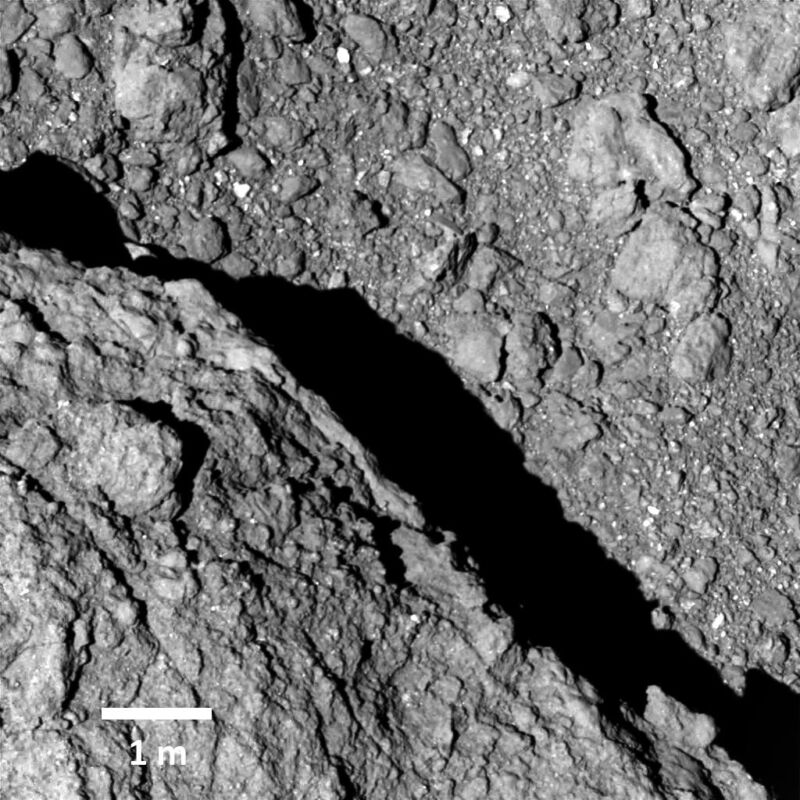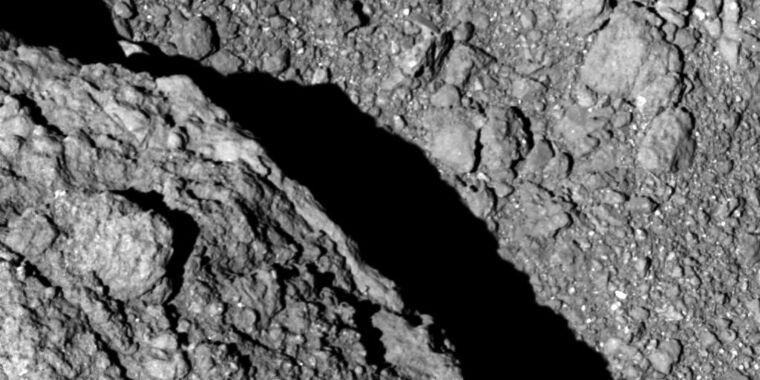
An asteroid that has been wandering through space for billions of years would be bombarded by everything from rocks to radiation. Billions of years of interplanetary space travel increase the odds of colliding with something in the vast void, and at least one of those impacts was powerful enough to leave the asteroid Ryugu forever changed.
When JAXA’s Hayabusa2 spacecraft landed on Ryugu, it collected samples from the surface that revealed that magnetite particles (which are normally magnetic) in the asteroid debris were devoid of magnetism. Now a team of researchers from Hokkaido University and several other institutions in Japan offers an explanation for how this material lost most of its magnetic properties. Their analysis showed that it was caused by the impact of at least one high-speed micrometeorite, which broke down the chemical composition of the magnetite so that it was no longer magnetic.
“We thought a pseudo-magnetite had been created [as] The researchers, led by Yuki Kimura, a professor at Hokkaido University, said in a study recently published in the journal Nature Communications that the cause of space weathering is the impact of micrometeorites.
what’s left…
Ryugu is a relatively small body that has no atmosphere, making it more vulnerable to space weathering — that is, alteration by micrometeorites and solar winds. Understanding space weathering can actually help us understand the evolution of asteroids and the solar system. The problem is that most of our information about asteroids comes from meteorites that fall to Earth, and the majority of those meteorites are pieces of rock from inside the asteroid, so they have not been exposed to the harsh environment of interplanetary space. They can also change as they descend through the atmosphere or through physical processes at the surface. The longer it takes to find a meteorite, the more information is likely to be lost.
Ryugu was previously part of a much larger body, a C-type, or carbonaceous, asteroid, meaning it was composed mostly of clay and silicate rocks. These minerals usually require water to form, but their presence is explained by Ryugu’s history. The asteroid itself is believed to have been born from debris after its original body was smashed to pieces in a collision. The original body was also covered in water ice, which explains the magnetite, carbonates and silicates found in Ryugu – they need water to form.
Magnetite is a paramagnetic (iron-containing and magnetic) mineral. It is present in all C-type asteroids and can be used to determine their remanent or residual magnetization. The permanent magnetization of an asteroid can reveal how strong the magnetic field was at the time and place of magnetite formation.
Kimura and his team were able to measure residual magnetization in two magnetite fragments (known as framboids because of their special shape) from the Ryugu sample. It is evidence of the presence of a magnetic field in the nebula in which our solar system was formed, and shows the strength of this magnetic field at the time magnetite was formed.
However, three other magnetite fragments were not magnetized at all. This is where space weathering comes into play.
…and what was lost
Using electron holography, which is done using a transmission electron microscope that sends high-energy electron waves through a sample, the researchers found that the three frames in question did not contain magnetic chemical structures. This made it radically different from magnetite.
Further analysis using a scanning electron microscope showed that the magnetite particles were mostly made of iron oxides, but there was less oxygen in those particles that had lost their magnetism, indicating that the material had undergone a chemical reduction, as electrons were donated to the system. . The loss of oxygen (and oxidized iron) explains the loss of magnetism, which depends on the organization of electrons in the magnetite. That’s why Kimura refers to it as “false magnetite.”
But what caused the reduction that led to the demagnetization of the magnetite in the first place? Kimura and his team discovered more than a hundred metallic iron molecules in the portion of the sample from which the demagnetized frames came. If a meteorite of a certain size had struck that region of Ryugu, it would have produced roughly that number of iron particles from magnetite framboids. Researchers believe that this mysterious object was rather small, or that it was moving incredibly quickly.
“As the impact velocity increases, the estimated projectile size decreases,” they said in the same study.
Pseudo-magnetite may seem like a quack, but it will actually help upcoming investigations seeking to learn more about what the early solar system was like. Its presence indicates the prior presence of water on the asteroid, as well as space weathering, such as micrometeorite bombardment, that affected the asteroid’s formation. The amount of magnetism loss also affects the overall survivability of the asteroid. Permanence is important in determining an object’s magnetism and the intensity of the magnetic field around it when it forms. What we know about the early solar system’s magnetic field has been reconstructed from survival records, much of which comes from magnetite.
Some of the magnetic properties of these particles may have been lost eons ago, but much can be gained in the future from what remains.
Nature Communications, 2024. DOI: 10.1038/s41467-024-47798-0

“Typical beer advocate. Future teen idol. Unapologetic tv practitioner. Music trailblazer.”







More Stories
Boeing May Not Be Able to Operate Starliner Before Space Station Is Destroyed
How did black holes get so big and so fast? The answer lies in the darkness
UNC student to become youngest woman to cross space on Blue Origin